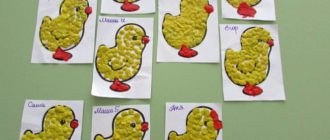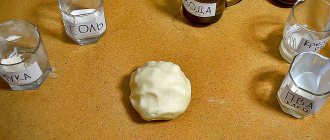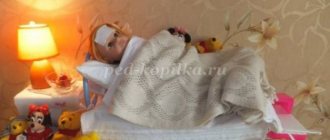GCD modeling in the middle group theme "Fish"
GCD Artistic and aesthetic development. Modeling
Middle group
Theme: Fish
Conducted by a teacher
Sarycheva Lyudmila Viktorovna
Goal: to develop in preschoolers the ability to create the image of a fish using modeling.
Visual tasks: teach children to correctly convey the structure of a fish’s body, proportions of parts, shape, size; develop coordination in the eye-hand system, synchronize the work of both hands.
Technical tasks: learn to divide a block of plasticine into parts; continue to teach children to pinch and pull plasticine away from the main shape (ventral and pectoral fins), to work with stacks (notch, cut plasticine); improve techniques: rolling, unrolling, smoothing.
Educational objectives: to cultivate independence and accuracy in work in preschoolers.
Preliminary work: examination of pictures depicting sea and freshwater fish, game “Loto. Inhabitants of reservoirs”, integration of educational areas: cognitive development, speech development, artistic and aesthetic (drawing), reading the book “To Little Why About the Sea”, riddles, coloring pages “Magic Fishes”, p/i “The Sea Is Worried”, p/i “ Pike and fish”, laying out fish from geometric shapes, “Tangram”, “Fold a square” with the aim of laying out pictures “Underwater World”.
Demonstration material: a large toy fish, a flat fish “Sazan Ivanovich”, on whatman paper there is an image of a lake (“School for young fry”) with algae (desks for fry), technological maps depicting the sequence of actions for creating elements.
1 Organizational part.
Guys, guess the riddle.
Wherever we want, we sail there.
The river is our home, we live in it... (Pisces)
I'll tell you a fabulous story about a fish. In a clear blue lake, next to green algae, lived a good old and wise fish. And the fish's name was Sazan Ivanovich. He had seen a lot in his time, he knew a lot. And Sazan Ivanovich decided to open a school for small fish - fry, in order to teach them wisdom. I wrote an advertisement in the lake newspaper and put up a sign with the inscription “School for Young Fry.” He waited a long time for the young students. He swam to the shore, swam far into the middle, but still didn’t wait. I was upset. Sazan Ivanovich really wanted to tell the kids important and necessary secrets...
Guys, I'm very sorry for the fish teacher. Do you want to help a kind and smart fish? But how can we help Sazan Ivanovich? Right. We will sculpt little fish and students will appear in the “School of Young Fry”.
2. Main part.
Look at the fish toy. Tell me, what parts does the body of a fish consist of?
Sensory examination. The teacher asks leading questions, helping the child to independently identify and compare the main parts and some details.
Finger gymnastics.
| A small fish swims along the river | put your palms together and tilt them to the sides |
| The little fish beats its tail | Stretch your arms forward and alternately wave your hands up and down, imitating waves or a ponytail. |
Teacher: - To start sculpting a fish, you need to divide a block of plasticine into parts. Visually divide it in half and draw a line with a stack. Then we visually divide one half in half again and cut it off - this is the “secret”. We put the “secret” in the upper right corner of the board. From a large piece we will sculpt an ovoid - a body along with a head and tail.
The teacher clarifies how the children will sculpt the ovoid and asks them to accompany the story with hand movements. Then he shows the children how to cut the narrowed part of the ovoid in stacks and move the two resulting halves to the sides - this is the tail.
The teacher calls the child for a demonstration. - Alena, show how you cut the narrowed part of the ovoid and move the cut parts to the sides (show on the finished model).
The teacher reinforces all explanations and demonstrations with mnemonic diagrams.
Teacher: - To make the tail flat and beautiful, we flatten the cut parts and cut them from the inside. Now we make the ventral fins, pinching them on both sides of the body. Nastya, how will you make the dorsal fin (child’s explanation). Do any of you have another option? (child's explanation)
Teacher: - That's right, the dorsal fin can be made by pinching, or it can be done in a constructive way: a small ovoid, flattened and stuck to the top of our fish. To do this, we use the “secret”. We coat the joint and smooth out all the irregularities.
The teacher offers to sculpt small fish. Turns on the music. During modeling, the teacher approaches the children, providing assistance and reminding them of the need to use a wet wipe. Each time he clarifies how the child will do this or that part of the craft. Let's release your fry into the lake. Let's put them at algae desks.
3. Analysis.
The teacher asks the children to tell about the most beautiful fish. He asks why they like her? Notes expressive eyes, a flat beautiful ponytail and a voluminous body, etc. He asks what the names of the fish they sculpted are, and how the dorsal fin was made.
- Guys, hear the bell ringing. A lesson begins at the School of Young Fry. Let's not disturb them.
The P/I “Pike and fry” is being held.
Children tidy up their workspaces, put boards and plasticine back in place, and place napkins to dry.
Summary of an integrated lesson in the middle group on modeling
Summary of an integrated lesson in the secondary preschool group “Funny Robots”
Author: Naidenysheva Larisa Anatolyevna, teacher, GBOU School No. 1373, Moscow Integration of educational areas: speech, physical, cognitive, artistic and aesthetic. Goal: To form aesthetic tastes, develop creativity and thinking. Objectives: - Continue to teach children to sculpt familiar objects in a constructive way. — To consolidate the ability to divide plasticine into parts of various sizes using a stack, to convey the proportions of parts of an object. — Learn to make objects stable. - Develop creativity. Material: Robot toy. Plasticine (two colors), stacks, a rag, a modeling board (for each child), sticks (tree branches - 2 cm - 5 pcs. and 1.5 cm - 2 pcs). Methods and techniques: surprise moment; mystery; conversation with children, song “Two Cheerful Geese”; fairy tale by K.I. Chukovsky “Hedgehogs Laugh”; physical minute.
Progress of the lesson
Educator: Guys, do you hear some strange sound? (turn on the robot sound) (If the children don’t guess right away, you can ask a riddle) Himself is metal, the Brain is electric. Children: It's a Robot! Educator: I wonder what happened to him. Let's find out. (The teacher takes the Robot and asks him) - What happened to you? Why are you so sad? Robot: I had a friend and he broke down. And I was left alone. Now I have no one to play with, talk to, walk with. Educator: Don't worry, Robot. The guys and I will definitely help you. I ask you not to be sad and smile! Robot: I can't laugh. I don't know how to do this. Educator: How is it possible to not be able to laugh? After all, laughter is such an interesting thing! Guys, let's teach Robot to laugh? Children: Let's go! Of course we will teach you! (The guys started to make Robot laugh: they showed him different funny faces, sang a funny song) Educator: Robot, but why aren’t you laughing. After all, the guys tried! Robot: I can only do what the inventors taught me. Educator: Then, I’ll tell you a fairy tale now, and you listen. (K.I. Chukovsky “Hedgehogs Laugh”) (And a miracle happened. Listening to a fairy tale about hedgehogs, the robot laughed merrily) Robot: Thank you very much! I learned to laugh! How - that's great! And I have a surprise for you. The robot conducts a physical exercise “Robot Dance” Educator: I always knew that laughter can work wonders! Thank you Robot for the fun dance! And now, the guys and I will help you meet new, cheerful friends! So that you have someone to play with, walk with, and just laugh with! Guys, please look at the robot. What is he like? What parts does it consist of? Children: Children's answers. Educator: That's right, guys. And today, I propose to fashion robots from plasticine. We will work with cut pieces of plasticine. Under no circumstances should they be rolled out. To create a robot we will need:
Plasticine (two colors), stacks, a rag, a modeling board, sticks (tree branches - 2 cm - 5 pcs. and 1.5 cm - 2 pcs).
Sequence of work: 1. Take a block of new plasticine and cut it using a stack into three parts: the largest part is the body; small rectangle - head; We cut the third part in half - the feet-stands.
2. We begin to assemble the robot using sticks (cut branches - 2 cm each). We attach the head to the body using a stick. We “put” the robot on its feet using sticks and foot stands. We add arms and “antennas” to the head, also from sticks.
3. Then we divide a small piece of plasticine into three parts and cut each part in half (six pieces are obtained). We use them to decorate small details: balls for the “antennas”, eyes, mouth and button on the body.
The robot is ready
Educator: Well done! Everyone can do it. (Move the Robot to the table on which the children will place the robot figures) Educator: Look, Robot, how many friends our kind and sympathetic children have made for you. Robot: Thank you very much, guys! I really liked my new friends! Educator: Thank you for your work, because you did a good deed - you made friends for our Robot. Now you can come up with a story about them: how they all met, became friends, and had fun together. (Writing a fairy tale) Summing up the lesson. Exhibition of children's works
We recommend watching:
Integrated music lesson in the middle group on the topic Spring Synopsis of cognitive direct educational activities in the middle group Integrated lesson in the middle group Synopsis of educational activities in the middle group. Unconventional drawing technique
Similar articles:
Summary of an integrated lesson in a middle group on the topic “How to find a path”
Math lesson “Rectangle” in the middle group of kindergarten
Mathematics lesson “Ordinal counting” in the middle group







